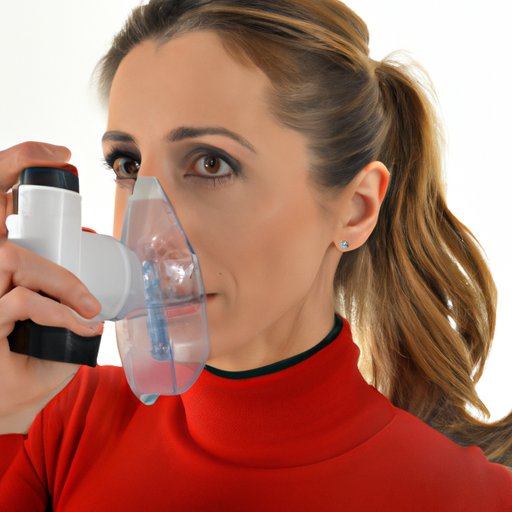
Introduction
Breathing treatments are an important aspect of respiratory care for individuals with conditions like asthma and COPD. They can improve lung function, ease breathing difficulties, and prevent exacerbations. In this comprehensive guide, we will explore the different types of breathing treatments available, how they work, and their benefits. We will also discuss how new advances in respiratory care are revolutionizing treatment options, insurance coverage and cost considerations, and what to expect during a breathing treatment.
Exploring the Benefits of Breathing Treatments: A Comprehensive Guide
A breathing treatment is a way to deliver medication directly into the lungs, allowing it to reach the the airways and lungs more quickly and efficiently. There are different types of breathing treatments available including nebulizers and inhalers. These treatments have been shown to effectively manage respiratory conditions like asthma, COPD, and cystic fibrosis.
Nebulizers work by converting liquid medication into a mist that can be inhaled through a mouthpiece or mask. Inhalers, on the other hand, deliver medication in a portable, compact device that is easy to carry. Both treatments work by opening up the airways, increasing blood flow to the lungs, and reducing inflammation so that patients can breathe more easily.
One of the key benefits of breathing treatments is that they can prevent exacerbations of respiratory conditions. Even if a patient is not currently experiencing breathing difficulties, regular breathing treatments can help improve their overall lung function and prevent flare-ups. Additionally, breathing treatments can help individuals with respiratory conditions to stay more active and enjoy a better quality of life.
A Beginner’s Guide to Breathing Treatments: What You Need to Know
If you are new to the idea of breathing treatments, you may be wondering who might benefit from them and how they are administered. Breathing treatments are typically used for individuals with respiratory conditions such as asthma, COPD, and cystic fibrosis. They can be administered at home or in a medical setting, depending on the patient’s needs.
If you have a respiratory condition that requires breathing treatments, you should talk to your healthcare provider about insurance coverage and cost considerations. Many insurance plans will cover the cost of breathing treatments, but it is important to know your specific coverage and any out-of-pocket expenses you may be responsible for.
During a breathing treatment, medication is delivered into the lungs through either a nebulizer or an inhaler. Patients must use the device correctly to ensure that the medication reaches its intended target and to minimize side effects. Common side effects of breathing treatments include jitteriness, increased heart rate, and dry mouth. If side effects are bothersome, patients should speak with their healthcare provider about adjusting their medication or dosage.
Frequently asked questions about breathing treatments include how often they need to be administered and if they can be used during pregnancy or while breastfeeding. Patients should always consult with their healthcare provider about their specific needs and concerns regarding breathing treatments.
How Breathing Treatments Are Revolutionizing Respiratory Care
New advances in respiratory care are changing the way we manage respiratory conditions. For example, telemedicine options now allow patients to receive care from the comfort of their own homes. Additionally, new medications are becoming available that can effectively treat even the most severe cases of asthma and COPD.
As healthcare professionals continue to learn more about the underlying causes of respiratory conditions, new treatments are being developed that target specific aspects of the disease process. This precision medicine approach allows for more targeted and effective treatment options for patients.
Patients who have tried the latest breathing treatments available have reported significantly improved quality of life, including less frequent exacerbations and reduced symptoms overall. Healthcare professionals are also better equipped to monitor patients’ respiratory health in real-time and adjust their treatment plans accordingly.
The Surprising Benefits of Breathing Treatments for Anxiety and Stress
Did you know that breathing treatments can also help manage mental health concerns like anxiety and stress? Deep breathing exercises and other forms of inhalation therapy can help improve lung function, reduce inflammation, and enhance the body’s natural relaxation response.
Studies have shown that regular deep breathing exercises can help reduce symptoms of anxiety and stress, including heart rate, blood pressure, and cortisol levels. Additionally, inhalation therapy with certain essential oils like lavender and chamomile can help calm the mind and reduce feelings of anxiety.
Individuals with respiratory conditions may find this particularly beneficial, as anxiety and stress can worsen breathing difficulties and exacerbate symptoms. By incorporating breathing treatments into their respiratory care routine, patients may be able to improve their overall physical and mental health.
What to Expect During a Breathing Treatment: A Step-by-Step Guide
If you are preparing for your first breathing treatment, you may be wondering what to expect. The process is typically straightforward and easy to follow:
- Wash your hands thoroughly
- Assemble your device according to the manufacturer’s instructions
- Measure out the appropriate dosage of medication and add it to the device
- Attach the mouthpiece or mask to the device
- Take slow, deep breaths through the mouthpiece or mask, following the prescribed instructions for the medication
- Repeat the process for the full dose of medication
After the breathing treatment, some patients may experience side effects like jitteriness or increased heart rate. If side effects are bothersome or persistent, patients should speak with their healthcare provider about adjusting their medication or dosage.
Conclusion
Breathing treatments are an important aspect of respiratory care for individuals with respiratory conditions like asthma and COPD. By opening up the airways and reducing inflammation, breathing treatments can improve lung function, prevent exacerbations, and improve overall quality of life. They are also becoming an important tool in managing mental health concerns like anxiety and stress. Patients who are interested in pursuing breathing treatments should speak with their healthcare provider about their specific needs and concerns.




